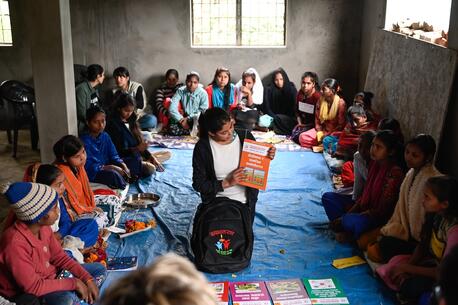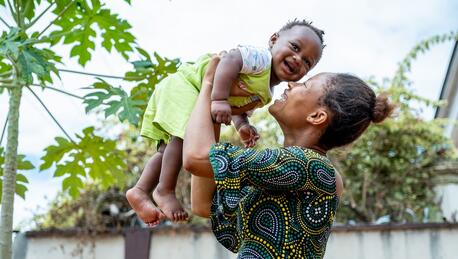We're right to have hope
It is hope—hope for a better, more equitable world; hope for a day when zero children die of preventable causes —that drives UNICEF’s work. At the U.S. Fund for UNICEF, it’s our job to spread that message of hope, and to secure the resources to sustain it and help it grow. But the world is a seemingly inhospitable place for optimism: famine in the Horn of Africa, flooding in Pakistan and El Salvador, and poverty, disease, and exploitation across the developing world. So I can’t help but ask the question: are we wrong to hope?
When asked about my job, I often tell people that I hope for a living (so often, as a matter of fact, that you’ll find it in my bio on my twitter feed. It is hope—hope for a better, more equitable world; hope for a day when zero children die of preventable causes —that drives UNICEF’s work. At the U.S. Fund for UNICEF, it’s our job to spread that message of hope, and to secure the resources to sustain it and help it grow. But the world is a seemingly inhospitable place for optimism: famine in the Horn of Africa, flooding in Pakistan and El Salvador, and poverty, disease, and exploitation across the developing world. So I can’t help but ask the question: are we wrong to hope? I recently had the opportunity to head to tiny, charming Camden, Maine to find out. (And I know, I know: the title is a bit of a spoiler.) A President, A Hip Hop Artist, and an MIT professor walk into an opera house… Camden’s beautiful opera house is host to PopTech, an annual conference that brings together an eclectic group of innovators in science and technology, business and entrepreneurship, the arts and academia to discuss, experience, and often create the ideas that are poised to reshape our world. If PopTech sounds august and avant-garde, that’s because it is; but don’t let that fool you into picturing an ivory tower perched high above the mid-Maine Coast. PopTech’s presenters – from President Ólafur Ragnar Grímsson of Iceland to Blitz, the Ambassador of Ghana by way of Brooklyn—are truly and deeply engaged in the dirty, difficult work of rethinking the world. And what’s more is that they do it for the same reasons UNICEF does it, and the same reason you’re on UNICEF’s Fieldnotes Blog reading this post: because you believe that we can leave a better world to our children.
It is hope—hope for a better, more equitable world; hope for a day when zero children die of preventable causes —that drives UNICEF’s work. At the U.S. Fund for UNICEF, it’s our job to spread that message of hope, and to secure the resources to sustain it and help it grow. But the world is a seemingly inhospitable place for optimism: famine in the Horn of Africa, flooding in Pakistan and El Salvador, and poverty, disease, and exploitation across the developing world. So I can’t help but ask the question: are we wrong to hope? I recently had the opportunity to head to tiny, charming Camden, Maine to find out. (And I know, I know: the title is a bit of a spoiler.) A President, A Hip Hop Artist, and an MIT professor walk into an opera house… Camden’s beautiful opera house is host to PopTech, an annual conference that brings together an eclectic group of innovators in science and technology, business and entrepreneurship, the arts and academia to discuss, experience, and often create the ideas that are poised to reshape our world. If PopTech sounds august and avant-garde, that’s because it is; but don’t let that fool you into picturing an ivory tower perched high above the mid-Maine Coast. PopTech’s presenters – from President Ólafur Ragnar Grímsson of Iceland to Blitz, the Ambassador of Ghana by way of Brooklyn—are truly and deeply engaged in the dirty, difficult work of rethinking the world. And what’s more is that they do it for the same reasons UNICEF does it, and the same reason you’re on UNICEF’s Fieldnotes Blog reading this post: because you believe that we can leave a better world to our children.
They do it because they—like me, like you—have hope. Take Dava Newman, Professor of Aeronautics and Astronautics and Engineering Systems at the Massachusetts Institute of Technology, who is developing the next generation of guaranteed-to-make-you-look-like-a-superhero space suits alongside NASA. Dr. Newman’s efforts have implications even more stellar than the interstellar: her work modeling and supporting human locomotion is helping to better the lives of children with Cerebral Palsy. Or Adrien Treuille, whose interest in using computers to simulate complex systems led him to co-create FoldIt, an honest to goodness, fun to play computer game that has players create models of the complex proteins that make up diseases like HIV—key to helping researchers understand how to combat the disease and help us realize an AIDS-free generation. Between Blitz, President Grímsson, Adrien, Dava, and their fellow presenters (not to mention the incredible attendees), I found a compelling cause for hope: some of the most amazing folks on earth are hard at work overcoming the seemingly intractable challenges that face children in the developing world. What I knew all along In retrospect, this doesn’t come as a surprise. When UNICEF thinks about partnerships, it does so with one thing in mind: an unshakeable belief that the world’s children deserve nothing less than the best and brightest minds working on their behalf. That’s why we work with industry leaders like UPS to improve our logistics; like frog design to help us rethink how to collaborate with Community Health Workers; and like Johnson & Johnson, who leveraged their expertise in user-centered design to help us reinvent our packaging of critical prenatal medications for HIV-positive mothers. And then there are those people within UNICEF, like UNICEF’s amazing Technology for Development team, who are solving longstanding challenges to serving the hardest-to-reach children by applying robust, widely-available technologies like SMS in new ways. And I would be remiss not to mention our team at UNICEF Uganda, who—along with U.S.-based engineers, students, and designers and Ugandan craftsmen—helped develop the Digital Drum, a rugged computing kiosk that was recently named one of Time Magazine’s best inventions of 2011. Nevertheless, it’s comforting to rediscover what I knew all along: we are right to have hope. The hope you and I share—in the face of famine, of poverty, or disaster—is not fragile, nor is it foolish or unfounded. Rather, it’s grounded in the knowledge that our vision of a more just, more equitable world is shared by the very same people who are shaping it.
P.S. To keep up with the latest on UNICEF’s incredible innovation efforts and the multitude of ways they’re making a better world for children, follow me on https://twitter.com/#!/JoshForUNICEF

